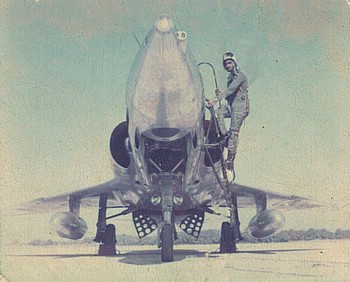The Story of the HAL HF-24 Marut, and its brief foray into conflict.
HAL (Hindustan Aircraft (today Aeronautics) Limited) built the first of 30 license produced Harlow PC-5A trainers, 48 Curtiss 75A-5P Hawk fighters and 74 Vultee V-12-D attack bombers on 29 Jul 41. During the war HAL license produced or carried out major repairs/overhauls of nearly every Allied aircraft operating in the CBI Theater from the Catalina to the Lightning. HAL’s design efforts began with the G-10 troop glider and finally fructified with the HT(Hindustan trainer)-2, a tandem low wing tail dragging basic trainer.
Experience with the license production of the Vampire and the Gnat led HAL to accept an IAF requirement of an advanced combat aircraft. Dr Kurt Tank (of Focke Wolfe fame) and his deputy Herr Mittlehuber were invited in Aug 56 to head the joint design team (Willy Messerschmidt having refused the offer and accepting the Spanish Government’s (later taken over by Egypt, Syria and Yemen (UAR)) offer to head the design of the Helwan fighter HA-003). Flight trials commenced on a full scale two seat wooden glider to test low speed handling and the phugoid modes.
This aircraft completed 86 glides towed aloft by a DC-3 Dakota before a nose wheel extension failure in flight ended the program on 24 Mar 60. The glider had wool tufting on the left wing to visualize airflow effects via a fin mounted camera. The glider revealed only a two knot stall warning and the fitment of a saw tooth on the wing leading edge finally gave the HF-24 a massive 28 kt warning (also unacceptable by military standards).
Taxi trials of the HF (Hindustan fighter) 001 commenced in Mar 61 and first flight was planned for the end of the month. However, due to some confusion about elevator authority and the elevator trim position required to unstick, the aircraft failed to lift off and the take off was aborted and undercarriage retracted. A second attempt was made after repairs on 17 Jun 61 with Wg Cdr Suranjan Das at the controls (later tragically killed during an engine failure on take off on the first flight of the reheated variant (by GTRE) of the Orpheus 703 on 10 Jan 70). A second flight for the defence minister was flown on 24 Jun 61 with the serial BR 462 and the aircraft renamed the HF-24.
Originally planned to fly with the 3700 Kg afterburning Orpheus B.Or 12 (Bristol Orpheus) engine and let down by successive failures to acquire the RB-153, SNECMA Atar 09K-53. the super Atar M-53 and finally the RB-199, the HF-24 entered service and served for the rest of its 15 year career with the critically underpowered license built Orpheus 703. among the quirks that characterized the aircraft were the unique nose oleo design that allowed it to be extended prior to take off to increase the incidence for take off and the wooden spacer provided as a last minute fix by Kurt Tank between the pilots seat and the saddle tank. The aircraft also had a 100 rocket pack behind the pilot that would extend into the airflow prior to firing.
The aircraft now named the “Marut” (Wind Spirit) entered service from Nov 69 with 10 Sqn (Daggers) and finally equipped three squadrons (10, 220 and 31) with an additional AD flight to train radar intercept officers. A total of 18 trainers designated Mk-ITs were also received. By the commencement of the 1971 Liberation war with Pakistan only two Squadrons (220 and 10) operated the type from Jodhpur and Uttarlai.
An emergency effort was made to clear the Marut for four gun firing but in the event Sqn Ldr Sapre of A&ATU (Aircraft and Armament Testing Unit) was killed when the aircraft rolled over into the sea off Jamnagar when he opened up with all four guns, Apparently the pawl in the roll control mechanism used to pop out with the vibrations and roll the aircraft hard over to the left. Although HAL found a solution for the problem, the aircraft was never again cleared for four gun firing (only the two lower guns were used with the other two having their ports blanked off).
Flying approx 200 sorties during the two week war, Maruts ranged 200 NMs into south Pakistan striking Hyderabad and Talhar airfields and interdicting railway systems at Mirpur Khas and Rohri. Maruts also helped finish the route of the Pakistani army’s 22 Cavalry at Longewala. A Marut flown by Sqn Ldr KK Bakshi of 220 Squadron also shot down a PAF F-86 Sabre on 07 Dec 71 (Flg Offr Hamid Khwaja of 15 Squadron PAF). No aircraft were lost to air action although by the end of the war three Maruts had been lost to ground fire (two POW, one KIA) and one lost on the ground.
The aircraft continued in service till 1982 when it was replaced by the MiG 23 BN. The aircraft will be remembered for its superb handling being called the “Super Hunter” by its pilots. A promising design that could cruise supersonic at 40,000 feet, the Marut finally met a disappointing end thanks to un-kept promises and international politics that embroiled HAL and several successive engine vendors. Thus ended India’s first true fighter design. It would be exactly 40 years since the Marut’s first flight when another indigenous design- the Light Combat Aircraft would take to the Indian skies again on 04 Jan 01.














